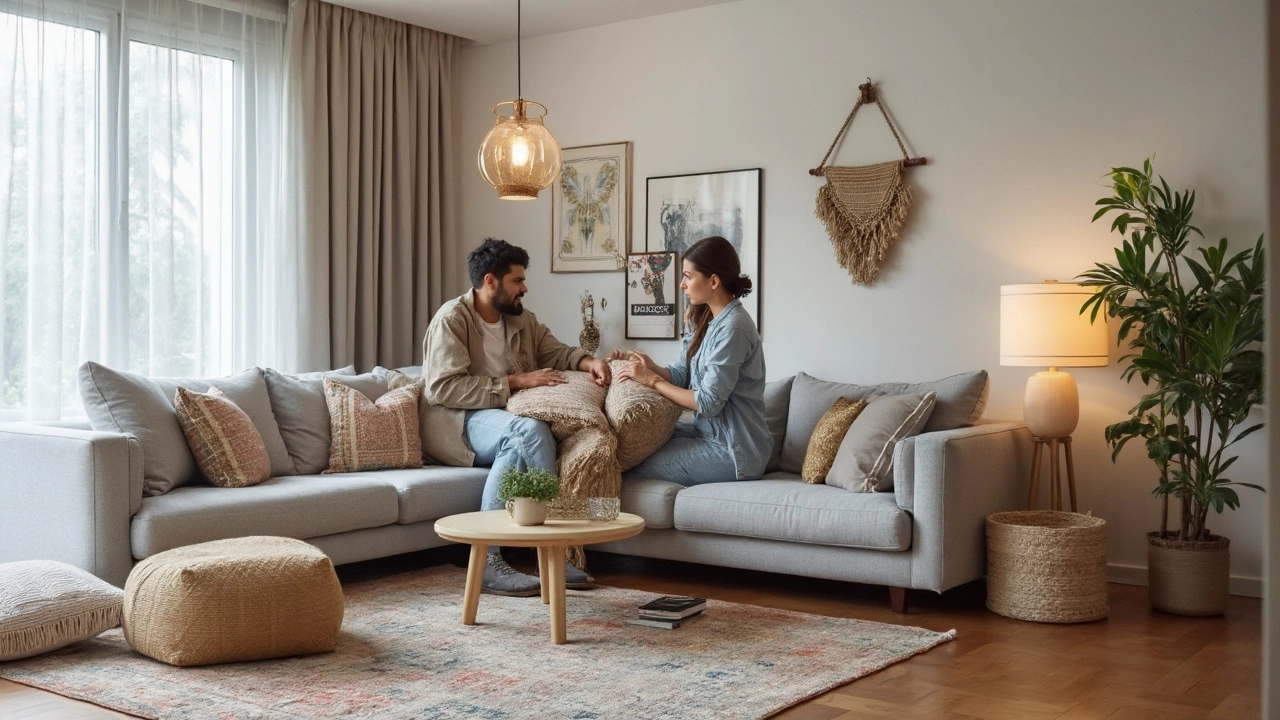Ever sat down and wondered why your corner sofa feels more like a leftover chess piece than the star player in your living room? You're not alone. Where you plop that sofa makes a huge difference in how your space looks and feels. Join two sofas together at the wrong angle or press them into an awkward corner, and suddenly, the room feels off.
Here's where a bit of furniture rearranging changes everything. Test out putting the corner sofa along two walls, but also try floating it midway out, away from the wall—a trick interior designers love. This creates zones, especially handy in open-plan spaces where you might want a lounging spot separate from your dining or study area. And don't forget, even the most basic corner sofa can look intentional (not accidental) with a little smart positioning.
- Finding the Perfect Spot
- Choosing Colors and Fabrics
- Accessorizing Like a Pro
- Keeping It Functional and Fresh
Finding the Perfect Spot
The spot you choose for your corner sofa can either make your room feel cozy and inviting or awkward and cramped. Before sliding the sofa into a corner just because it fits, step back and look at your space. Ask yourself, which areas get the best light during the day? Is there a point in the room you want to highlight, like a window, fireplace, or TV?
Most people default to tucking a corner sofa tight into two walls. Sure, that makes sense if your room is small. But floating your sofa—even just a few inches from the wall—can make the edges stand out and create a more open space. In bigger rooms, floating the sofa further into the room can act as a divider without blocking the flow. Open-plan living rooms especially benefit from this because you can clearly break up the lounge from the dining or kitchen area.
Here’s a simple process to pin down the sweet spot:
- Measure first. Grab a tape measure and jot down the dimensions of the sofa and your room. Double check doorways—one in five people who buy large furniture find it doesn’t actually fit the way they imagined.
- Plan around outlets and walkways. Make sure placing your sofa won’t block plugs or traffic paths.
- Think about your view. You’ll want to see the TV, chat with family, and maybe even enjoy the morning sun. Test out facing the sofa toward a focal point, not just a blank wall.
To help you sort out typical room sizes and common sofa dimensions, check out this table:
| Room Type | Avg. Size (sq ft) | Common Sofa Size (inches) |
|---|---|---|
| Small Living Room | 120–200 | 78–85 (width) x 78–85 (length) |
| Open Plan | 300+ | 90–120 (width) x 90–120 (length) |
You don’t have to stick with corners or traditional layouts. Some folks even place their corner sofa in the center, using the back as a barrier between “zones” in the room. If you can see every seat from your favorite spot and have space to walk behind it, you’re probably onto something good.
Choosing Colors and Fabrics
Picking the right colors and fabrics isn't just about matching your wall paint. There's a bit of science (and a lot of mistakes) behind what makes a corner sofa look pulled together instead of out of place. For starters, lighter colors make your room feel bigger, while darker shades can anchor a space and add that cozy vibe. Go neutral if you like swapping out accessories often. But if you want your sofa to be the main attraction, bold colors or patterns don't disappoint.
Fabric choice isn’t just a style thing—it’s survival, especially if you’ve got pets, kids, or a clumsy roommate. Microfiber holds up against spills and is easy to clean. Leather tends to last longer and looks good with age, but it can be pricey and scratches easily. If you’re hunting for the best of both worlds, look for stain-resistant polyester blends. They’re tough, come in every color, and don’t cost a fortune.
To give you an idea of what’s popular (and why), check this comparison table:
| Fabric | Main Benefit | Drawback |
|---|---|---|
| Microfiber | Stain resistant, budget-friendly | May wear thin over time |
| Leather | Durable, gets better with age | Scratches, more expensive |
| Polyester Blend | Resists stains, huge variety | Not as soft as cotton |
| Velvet | Soft & looks luxe | Can trap dust or pet hair |
Mixing textures works really well too. Try layering a linen or cotton throw on a plush sofa. It’s not just for looks: different materials feel nice and add visual interest even if you go all in on one color. If you have a dark-color sofa, add lighter pillows or a chunky knit blanket to break things up. It keeps your room from feeling too heavy.
One last tip—if you feel stuck, snap a photo of your whole room and view it in black and white. It helps you see if the shades clash or work together. Designers swear by it. Small detail, big difference.

Accessorizing Like a Pro
Piling on accessories is where your corner sofa goes from basic to wow. Most folks underestimate what some good throws and cushions can do. Try mixing cushion sizes—pair two big ones with a couple of smaller, patterned throws. Experts recommend odd numbers here (think: three or five cushions), since it looks more natural and less showroom. For color, grab at least one bright accent or a bold pattern to add pop. This is especially key if your corner sofa is neutral.
Layering up a textured blanket across the chaise or one side creates a lived-in, inviting vibe. If you’re worried about mess, choose throws that are machine washable. Materials like chunky knit or soft wool add interest and keep things cozy year-round.
Don’t forget the coffee table or side table. A stylish tray for remotes or a couple of books makes the area practical and polished. Fast fact: A survey from Apartment Therapy found that 68% of people feel more relaxed with a candle or plant in their living area. Even a small succulent or a low-maintenance snake plant adds life and color.
- Go for odd-numbered cushion groupings—looks more spontaneous.
- Use throws that are easy to clean and textured for coziness.
- Add a tray or basket on tables to control clutter and keep things handy.
- Bring in one or two plants for freshness—real or fake if you’re not a plant person.
Lighting matters more than you’d think. Try a floor lamp right behind the end of the sofa to create a cozy corner. Or toss a table lamp on a nearby side table for softer, layered light at night.
| Accessory | Adds to Space | Ease of Update |
|---|---|---|
| Cushions | Color, comfort, style | Very easy |
| Throw blankets | Texture, warmth | Very easy |
| Plants | Freshness, color | Easy |
| Lamps | Ambience, character | Easy |
| Trays/Baskets | Organization | Very easy |
Don’t be afraid to swap accessories seasonally. Lighter fabric and fresh colors for spring and bolder, warmer tones for winter mean your sofa spot always feels new. Just a few changes can flip the whole mood.
Keeping It Functional and Fresh
There’s no point in having a stylish corner sofa if it turns into a clutter magnet or feels uncomfortable after a week. Let’s talk function first. Pick a corner sofa with built-in storage options—many brands offer hidden compartments under seats or in chaises. That’s perfect for tossing in throws, extra pillows, or even board games. Out of sight, out of mind.
Coffee tables or ottomans with storage pair great with corner sofas, making the space feel tidy. If you have kids or pets, go for durable fabrics like microfiber or easy-clean options. Did you know that microfiber resists stains and can handle serious wear and tear? That’s why you see it in so many family-friendly living rooms.
Want to keep things fresh? Swap your scatter cushions and throws with the seasons. Light, cotton covers in summer, chunky knits in winter. Rotate furniture if the room allows—moving your sofa just a few feet can change the whole vibe and help prevent the fabric from fading unevenly if you get a lot of sunshine. Regularly fluff the cushions and vacuum underneath. Sounds simple, but loads of people forget, and that’s when things start looking sad and saggy.
Here’s a quick checklist:
- Wipe down and vacuum weekly—especially under the cushions.
- Check and tighten bolts or legs every few months to stop wobbling.
- Switch up accessories now and then so your corner sofa always feels up to date.
- Look out for modular sofas—these let you rearrange sections, so your setup stays adaptable as your space or needs change.
Functional doesn’t have to mean boring. The secret is mixing practical choices with small changes here and there, so your sofa keeps up with your life—and always looks good.

